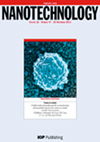投稿信息
投稿信息
审稿周期
投稿命中率
审稿费用
暂无数据
版面费用
暂无数据
中国人发表比例
2023年中国人文章占该期刊总数量暂无数据 (2022年为100.00%)
自引率
7.0 %
年文章数
13308
作者需知
暂无数据
NCBI查询
偏重的研究方向
期刊简介
稿件收录要求
稿件收录要求
In response to the growth in research in the area and the extension of nanotechnology across traditional academic fields the journal will be changing its scope from January 2002. The new scope will strongly reflect the interdisciplinary aspect of nanoscale science and technology with the aim of becoming the primary source of information in this ever expanding field. In the meantime we invite authors who work at the forefront of nanoscale science and technology, and especially those in interdisciplinary areas, to submit their papers to the journal. Present subject coverage. Papers are expected to be original experimental or theoretical research or to be an original synthesis or analysis of subjects related to nanotechnology. Here, nanotechnology is taken to include all those technologies and enabling technologies associated with either the 'top-down' approach to fabricating miniature elements by sculpting the desired structure from a macroscopic piece of material, as well as the 'bottom-up' approach of building the desired structure atom by atom or molecule by molecule. Typical appropriate topics include, but are not limited to: engineering fabrication involving atomic level machining and metrology involving dimension, size and tolerances less than the wavelength of light and down to values of at largest 0.2 nm, but preferably to x-ray levels and beyond; performance of micromechanisms such as microactuators to subnanometre and molecular levels; the design of instruments and machine tools capable of measuring, performing and manufacturing to nanometre levels; the application of nanometre level instruments such as scanning tunnelling microscopes and atomic force microscopes to biology, medicine and materials science; miniaturization of electronic, mechanical and optical components, and their fabrication with such methods as ion-beam removal and deposition, molecular-beam epitaxy and electron-beam and photon-beam lithography; fabrication and use of field-emission vacuum microelectronic devices; nanoelectronics including nanometre scale semiconductor structures and their potential electronic device applications; molecular engineering--either molecular scale components or new molecular materials exhibiting unique electronic, mechanical or optical properties; nanoprecision instrumentation, e.g., x-ray multilayer thin-film fabrication and associated surface processing.




